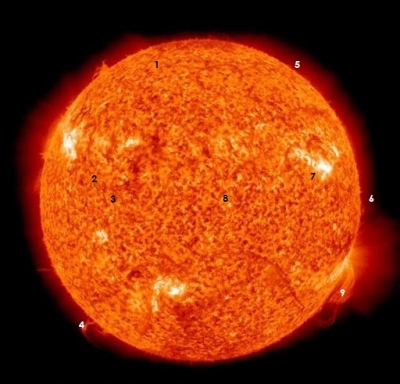
SUN
The Sun is the closest star to Earth and the centre of our Solar System. This vast ball consists of hot luminous gas kept together by gravity. About three quarters is hydrogen and almost all the rest is helium, with small amounts of about 90 other elements. More than half of the gas is squashed in the Sun’s core where nuclear reactions convert hydrogen to helium and in the process produce huge amounts of energy. This energy is released through the Sun’s surface, most familiarly as heat and light. The Sun has been producing energy in this way for about 4.6 billion years and will do so for another 5 billion or so. This image shows the Sun not as it appears to the human eye, but in ultraviolet light.
- SIZE The Sun is the largest body in the Solar System. It measures 1.4 million km (870,000 miles) in diameter, which means that 109 Earths could fit across its face. The Sun is made of 330,000 times more material than Earth, and 1.3 million Earths would fit inside it.
- PHOTOSPHERE Like other stars, the Sun is not solid but has a visible surface called the photosphere – a violent place where jets and flares of gas constantly shoot into space. It is made of 1,000-km (620-mile) wide short-lived granules of rising gas, which together resemble orange peel.
- TEMPERATURE The temperature of the surface is 5,500°C (9,900°F), and it is this that gives the Sun its yellow colour. Cooler stars are red, hotter ones are white. Inside is much hotter. The core is 15 million°C (27 million°F) and nuclear reactions here convert 600 million tonnes of hydrogen to helium every second.
- PROMINENCE Giant clouds and sheets of relatively cool gas that loop and arch from the surface are called prominences. This one extends out the equivalent of about 20 Earths. The gas is propelled from the surface by enormous force built up by magnetic fields inside the Sun.
- SPICULES Short-lived flame-like jets of gas called spicules continuously leap about 10,000 km (6,200 miles) from the surface.
- ATMOSPHERE Directly above the surface is the chromosphere, the inner atmosphere that extends out about 2,500 km (1,550 miles). Beyond is the corona, which extends for millions of kilometres into space. Only the inner corona is visible here.
- FACULAE The hottest areas, which appear almost white, are faculae. They are particularly active regions produced by concentrations in the Sun’s magnetic field.
- SPIN Unlike Earth, which is solid and spins as a whole, different parts of the Sun spin in different amounts of time. The equator makes one rotation every 25 days; regions near the poles take another five or so days.
- CORONAL MASS EJECTION This twisting prominence was associated with a coronal mass ejection – a large bubble of billions of tonnes of gas that blasted away from the Sun.
Picture Credit : Google




